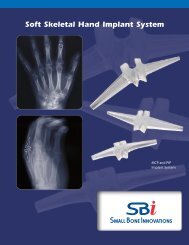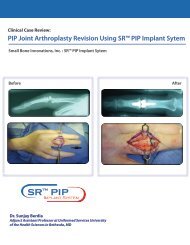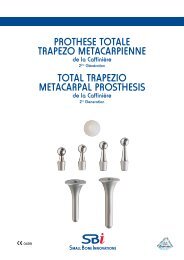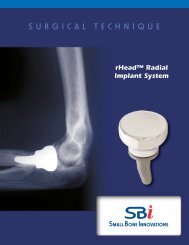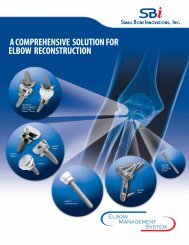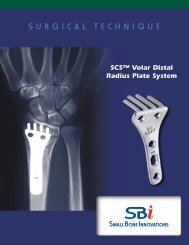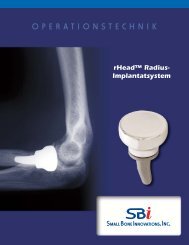PGT INSTRUmENTATIoN - Small Bone Innovations
PGT INSTRUmENTATIoN - Small Bone Innovations
PGT INSTRUmENTATIoN - Small Bone Innovations
You also want an ePaper? Increase the reach of your titles
YUMPU automatically turns print PDFs into web optimized ePapers that Google loves.
After insuring there is enough space for at least a 6 mm polyethylene<br />
bearing, the foot is plantar flexed to achieve better exposure of<br />
the talus. The talar sizer (FIGURE 15) is centered on cut surface of the<br />
dorsal talus to confirm that there is a minimum 12 mm A/P depth on<br />
this cut. (FIGURE 16a & b, Table 1) (All of the talar implants have a 12<br />
mm inside Anterior/Posterior dimension. The medial/lateral width<br />
varies depending upon the size of the talar component)<br />
Talar Component Outside Largest Dimension<br />
XXS XS S M LG<br />
ML Dimension 28 30 34 36 38<br />
AP Dimension 29 31 35 35 35<br />
Figure 15<br />
Table 1<br />
An appropriate sized talar component for a patient will leave<br />
3 mm of exposed talar surface on both the medial and lateral<br />
sides of the guide. Using a skin marker, outline the anterior corners<br />
of the talar sizer to aid in placement of the appropriate size<br />
datum.<br />
The above chart shows the outside dimensions of the talar components.<br />
A measurement of the distance between malleoli may be<br />
taken to ensure the appropriate size is selected. When the measurement<br />
is in-between sizes, select the smaller size.<br />
Figure 16a<br />
Figure 16b<br />
9








